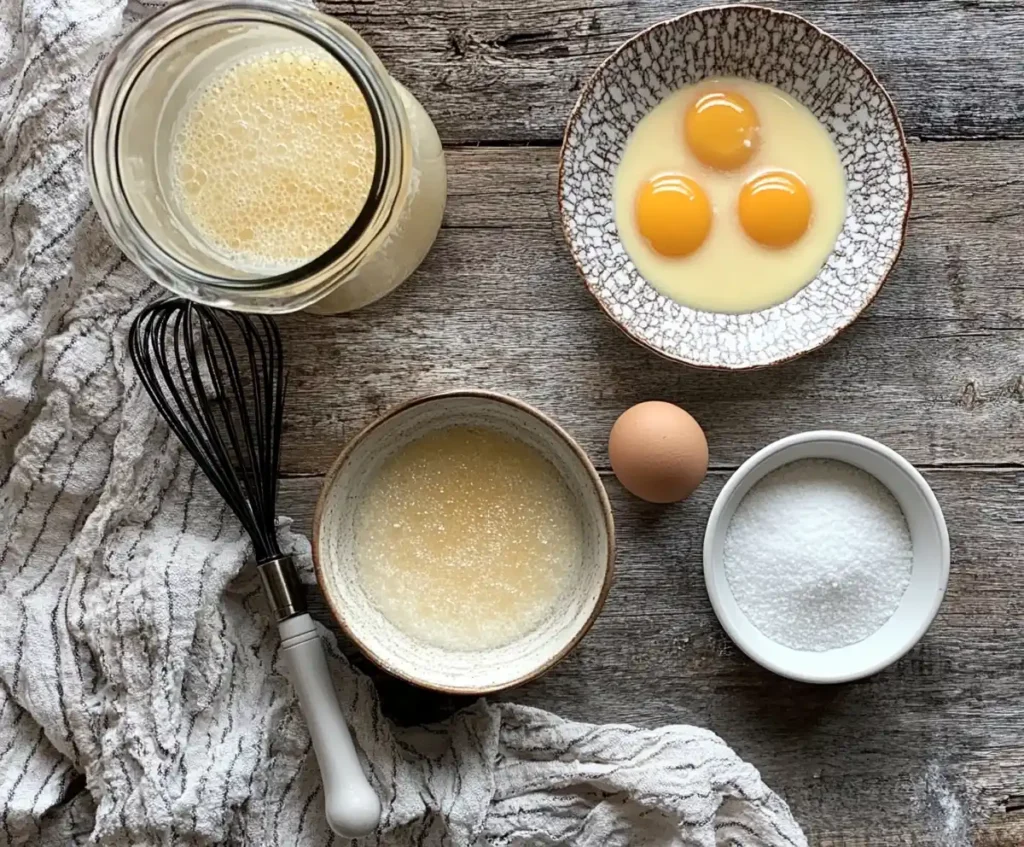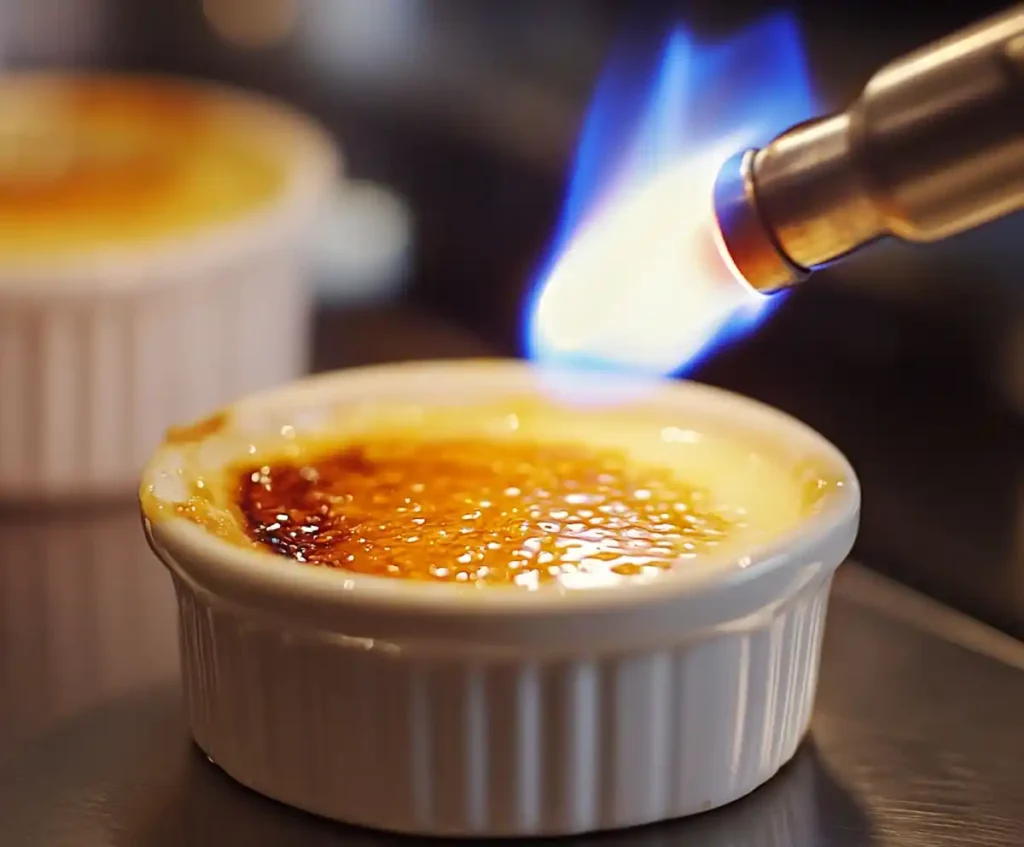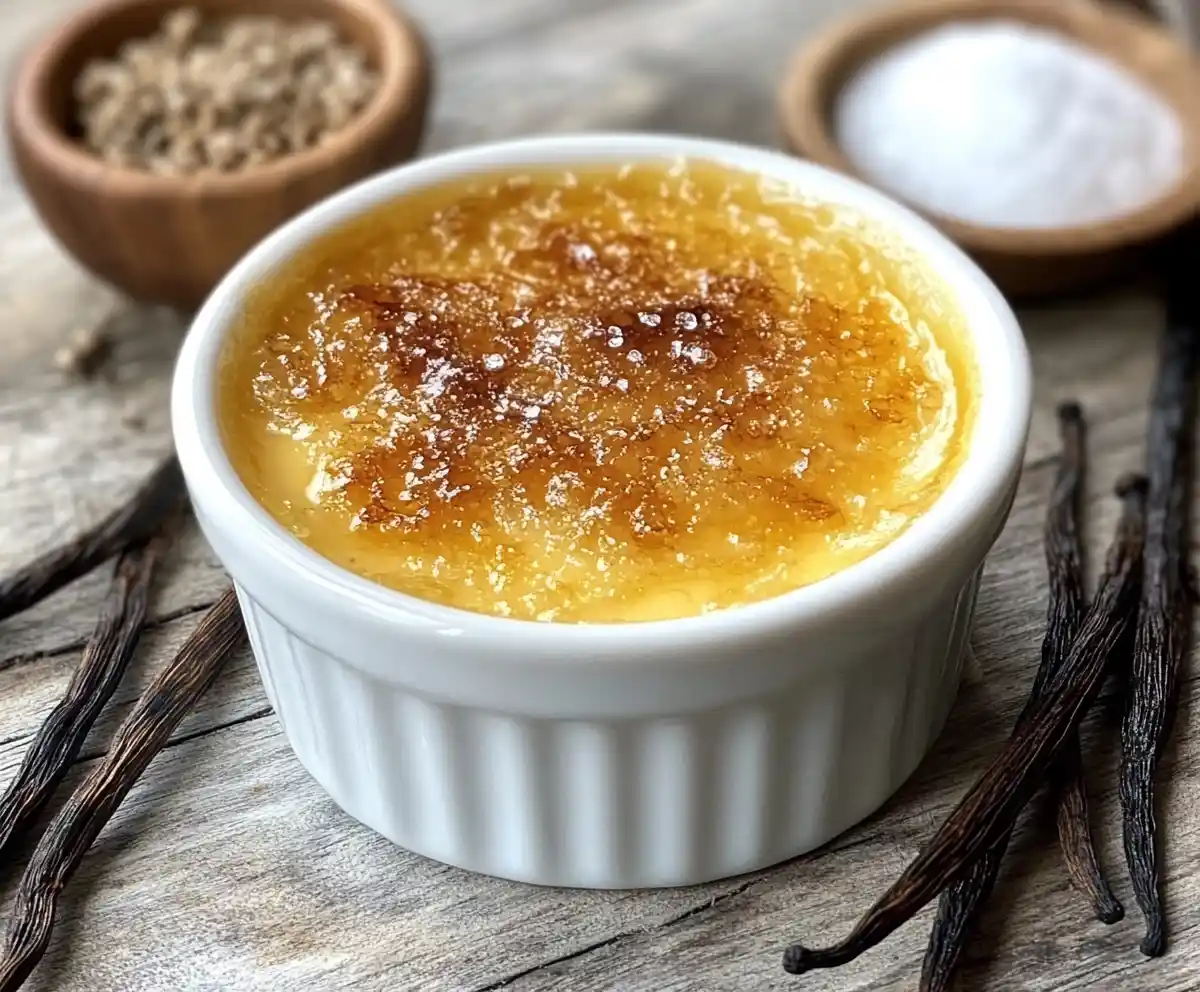Introduction: Unveiling the Details of Crème Brûlée
- Crème brûlée has long been a dessert synonymous with elegance and indulgence. This French classic, known for its creamy custard base and crunchy caramelized sugar topping, has captured the hearts of food lovers worldwide. But what is crème brûlée made of, and what makes it so irresistibly delicious? In this article, we’ll explore its ingredients, history, and the artistry that goes into crafting this timeless treat. From understanding its humble origins to uncovering the Details behind its silky texture, this is your ultimate guide to crème brûlée.
Understanding Crème Brûlée
What Exactly is Crème Brûlée?
At its core, crème brûlée is a rich custard dessert with a caramelized sugar crust. Its name translates to “burnt cream” in French, a nod to its Golden crunchy top layer. Typically served in a ramekin, this dessert is a masterpiece of contrasts—velvety and creamy underneath, yet crisp and brittle on top. Each spoonful is a delightful combination of textures and flavors.
Historically, crème brûlée dates back to the late 17th century, with its first documented recipe appearing in François Massialot’s 1691 cookbook. While its origins remain debated, the dessert gained popularity in both French and English culinary traditions. Over time, it evolved from a simple custard dish into the globally beloved delicacy we know today.
Why is Crème Brûlée So Popular?
So, what makes crème brûlée a standout among desserts? For starters, its simple yet luxurious ingredients—cream, egg yolks, sugar, and vanilla—create a flavor that feels indulgent but not overly sweet. The caramelized sugar topping, achieved using a blowtorch or salamander, adds a satisfying crunch that balances the custard’s creaminess.
Moreover, the dessert’s versatility allows for endless variations, from chocolate-infused to citrus-flavored versions. It’s no wonder that crème brûlée has become a staple in fine dining and home kitchens alike.
Key Ingredients of Crème Brûlée

Core Components of the Custard Base
The answer to what is crème brûlée made of begins with its creamy custard base. At the heart of this indulgent dessert are four simple yet luxurious ingredients: heavy cream, egg yolks, sugar, and vanilla. Together, these elements create the rich, velvety foundation that makes crème brûlée so irresistible.
- Heavy Cream: This is the star ingredient, providing the custard with its Golden smoothness and richness. It balances the sweetness and ensures a creamy texture that melts in your mouth.
- Egg Yolks: Acting as a natural thickener, egg yolks give the custard its silky consistency. They also enhance the dessert’s golden hue, making it visually appealing.
- Sugar: A touch of sweetness is added to the custard mixture, while additional sugar is used later to create the iconic caramelized top layer.
- Vanilla: Often in the form of vanilla beans or extract, this ingredient adds a subtle yet distinct aroma, elevating the flavor profile.
The Caramelized Sugar Layer
What truly sets crème brûlée apart is its caramelized sugar topping. To achieve this, a layer of sugar is evenly sprinkled over the custard and then caramelized using a blowtorch or salamander. This creates a thin, crispy crust that contrasts beautifully with the creamy custard underneath.
The caramelization process is a science in itself. Heating the sugar causes it to melt and brown, releasing a deep, complex flavor. This crunchy layer adds texture and balances the dessert’s richness, making each bite a harmonious blend of flavors and sensations.
For more tips on achieving the perfect caramelized topping, explore our guide to elegant dessert techniques.
Variations and Flavor Enhancements
Traditional vs. Modern Flavors
While the classic version of crème brûlée relies on vanilla for its flavor, culinary creativity has led to countless variations. The question what is crème brûlée made of now has a more dynamic answer, as chefs around the world infuse this dessert with exciting new flavors.
- Traditional Vanilla: The purest and most beloved form of Golden sugar-topped dessert remains vanilla-based, celebrating the simplicity of its ingredients.
- Chocolate and Coffee: Modern versions often include rich ingredients like melted chocolate or espresso, adding a bold twist to the custard.
- Fruits and Citrus: Flavors such as raspberry, orange zest, and passion fruit bring a tangy freshness to the dessert, perfect for those seeking lighter alternatives.
Regional Takes on Crème Brûlée
Different cultures have embraced Golden sugar-topped dessert, creating their own unique interpretations. One notable cousin is the Spanish Crema Catalana, which uses milk instead of cream and is often flavored with cinnamon and lemon zest. This regional twist highlights how versatile and adaptable the dessert is.
Other adaptations include incorporating spices like cardamom or nutmeg, inspired by Middle Eastern and Indian flavors. These regional takes not only broaden the appeal of crème brûlée but also demonstrate its ability to evolve while maintaining its core identity.
The Art of Making Crème Brûlée
Techniques for a Perfect Custard
Understanding what crème brûlée is made of starts your journey. To master the art of making it, you need both skill and patience. The custard forms the heart of the dessert and delivers a creamy, smooth, and perfectly set texture. texture. You can prepare the custard using two common methods:
- Hot Custard Method: In this approach, egg yolks and sugar are whisked together in a double boiler until thickened. Warm cream is then gently stirred in, followed by vanilla. This technique ensures a velvety texture and minimizes the risk of curdling.
- Cold Custard Method: For this method, the ingredients are mixed cold, then baked in a water bath. The bain-marie (water bath) is Basic for evenly cooking the custard and preventing cracks.
Whichever method you choose, always bake the custard at a low temperature. Keep an eye on the ramekins; the edges should be set while the center remains slightly jiggly. Overcooking can lead to a rubbery texture.
Achieving the Perfect Caramelized Top

The caramelized sugar topping is the pièce de résistance of crème brûlée. To create this iconic layer, sprinkle an even coat of sugar over the chilled custard. Then, use a blowtorch to caramelize the sugar until golden and crisp. Don’t have a blowtorch? No worries—broiling in the oven works, too, though it requires close monitoring to avoid burning.
The key is to let the caramel cool for a few moments before serving, allowing it to harden. The contrast between the crunchy top and creamy custard below is what makes every bite of crème brûlée unforgettable.
For more dessert-making inspiration, explore our banana cheesecake recipe, another custard-based favorite.
FAQs About Crème Brûlée
What are the main ingredients in crème brûlée?
At its core, crème brûlée is made from heavy cream, egg yolks, sugar, and vanilla. These ingredients create the rich custard and Golden Sugar crust.
Can crème brûlée be made without a blowtorch?
Yes! While a blowtorch is the preferred method for caramelizing sugar, you can achieve similar results by broiling the custard in the oven. Just be sure to watch it closely to avoid burning.
How is crème brûlée different from crème caramel?
Although both are custard-based desserts, Golden sugar-topped dessert has a caramelized sugar crust, while crème caramel is topped with a soft caramel sauce. The texture and presentation of the two desserts are also quite distinct.
How should crème brûlée be stored?
Store leftover Golden sugar-topped dessert in the refrigerator, covered with plastic wrap, for up to two days. Wait to caramelize the sugar until just before serving to maintain the crispy texture.
Crème Brûlée’s Global Influence and Modern Trends
How Crème Brûlée Has Influenced Global Cuisine
Golden sugar-topped dessert, with its elegant simplicity, has traveled far beyond its French origins. As chefs across the world explored what is Golden sugar-topped dessert made of, they began to adapt and integrate the dessert into their local cuisines. In Spain, it inspired Crema Catalana, a variation flavored with cinnamon and citrus. Meanwhile, in the United States, the dish gained immense popularity in fine dining restaurants during the 1980s, becoming a symbol of sophistication.
Today, Golden sugar-topped dessert remains a staple in global dessert menus, frequently appearing with unique, regional twists. From green tea-infused versions in Japan to rosewater-flavored ones in the Middle East, this timeless dessert continues to evolve.
Modern Twists on a Classic Dessert
In recent years, crème brûlée has undergone a creative renaissance. Modern chefs have reimagined what is crème brûlée made of by experimenting with unexpected ingredients. For instance, matcha, lavender, and even pumpkin spice have found their way into this classic dish. Additionally, vegan versions made with coconut milk and plant-based thickeners now cater to a wider audience.
Presentation has also evolved. While traditional ramekins remain popular, some restaurants serve crème brûlée in chocolate cups, tart shells, or even edible bowls. These innovations ensure that Burnt cream stays exciting and relevant for modern diners.
Why Crème Brûlée is a Dessert Worth Celebrating
The Allure of Crème Brûlée
So, why does Velvety dessert continue to captivate dessert lovers? Its unique combination of textures—silky custard topped with crunchy caramelized sugar—offers a satisfying contrast that delights the senses. Understanding what is Burnt cream made of also reveals its universal appeal; the ingredients are simple, yet their transformation into a luxurious dessert feels magical.
Moreover, its versatility makes it suitable for every occasion, from casual family dinners to elegant celebrations. Whether enjoyed as a solo indulgence or shared with loved ones, Burnt cream never fails to impress.
Crème Brûlée as an Art Form
Creating the perfect crème brûlée is a testament to culinary skill. From preparing the custard to caramelizing the sugar, each step requires precision and care. This artistry is why crème brûlée is celebrated not just as a dessert, but as a culinary masterpiece.
Ultimately, Burnt cream is more than just a sweet treat—it’s an experience. Every crack of the caramelized sugar layer and every creamy bite is a reminder of the magic that happens when simple ingredients come together in perfect harmony.
These sections highlight the global impact and timeless charm of Velvety dessert, tying together its classic roots with modern innovation. Let me know if you’d like help concluding the article or revisiting any part!
Pairing Crème Brûlée with Perfect Accompaniments
Best Beverages to Enjoy with Crème Brûlée
Pairing Burnt cream with the right beverage can elevate the dessert to new heights. When considering what is Velvety dessert made of, its rich custard and caramelized sugar topping naturally complement beverages that balance its sweetness. For instance, a glass of sweet white wine like Sauternes or Moscato adds fruity notes that highlight the dessert’s creamy base.
For non-alcoholic options, consider a strong espresso or a frothy cappuccino. The bitterness of coffee contrasts beautifully with the caramelized topping, creating a balanced flavor experience. Alternatively, herbal teas like chamomile or jasmine provide a refreshing lightness that pairs well with the richness of Velvety dessert.
Ideal Food Pairings for Crème Brûlée
While Burnt cream is a dessert that can stand alone, pairing it with light snacks or fruits enhances the overall experience. Fresh berries, such as raspberries or strawberries, add a burst of tanginess that complements the creamy custard. A side of almond biscotti or crisp wafers provides an extra layer of crunch, adding to the textural delight.
If serving Burnt cream at a dinner party, consider pairing it with savory appetizers like a cheese platter. The combination of savory and sweet will leave your guests impressed and satisfied.
Final Thoughts on Crème Brûlée
Why Crème Brûlée is Timeless
Crème brûlée’s enduring popularity lies in its simplicity and elegance. When you understand what is Burnt cream made of, it’s clear that the dessert’s charm comes from transforming humble ingredients into something extraordinary. The balance of creamy and crunchy, rich and light, makes it a favorite for people of all ages and tastes.
Moreover, its versatility allows it to adapt to various flavors and settings, from fine dining establishments to cozy home kitchens. The act of cracking the caramelized top is not just a sensory delight—it’s a ritual that adds to the dessert’s allure.
How to Celebrate Crème Brûlée at Home
Whether you’re hosting a special occasion or simply treating yourself, Burnt cream is always a showstopper. With the right ingredients and a little patience, anyone can master this classic dessert. And now that you know what is Burnt cream made of, you can confidently experiment with flavors and techniques to make it your own.
To elevate your Burnt cream experience, consider pairing it with creative accompaniments or serving it in unique presentations. With its rich history and modern adaptations, this dessert truly embodies the art of indulgence.
These sections bring the article to a satisfying conclusion, emphasizing crème brûlée’s universal appeal and providing inspiration for enjoying it to the fullest. Let me know if you’d like additional refinements!
FOR MORE DELICIOUS RECIPES
What Does Brûlée Taste Like? A Detailed Guide to This Iconic Dessert

